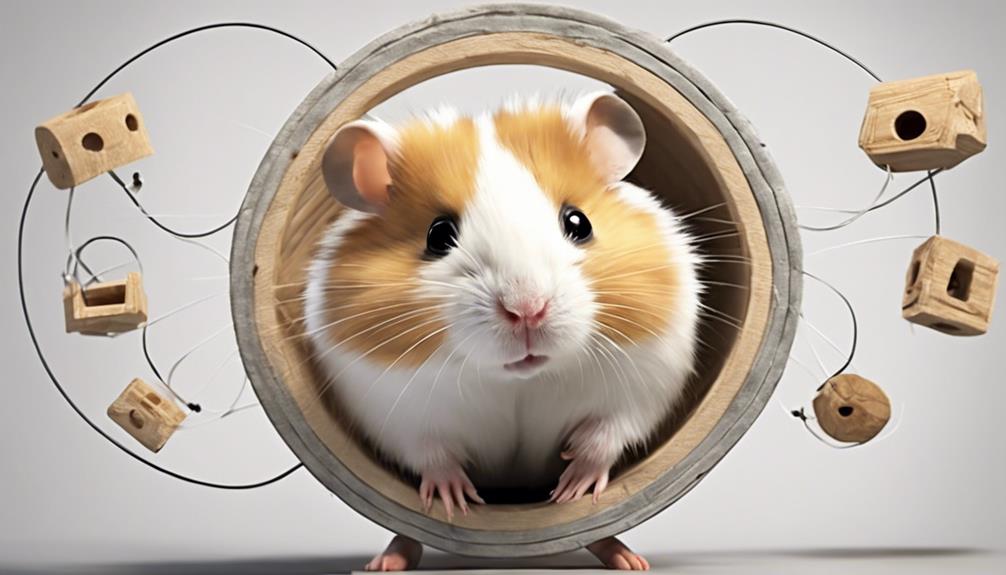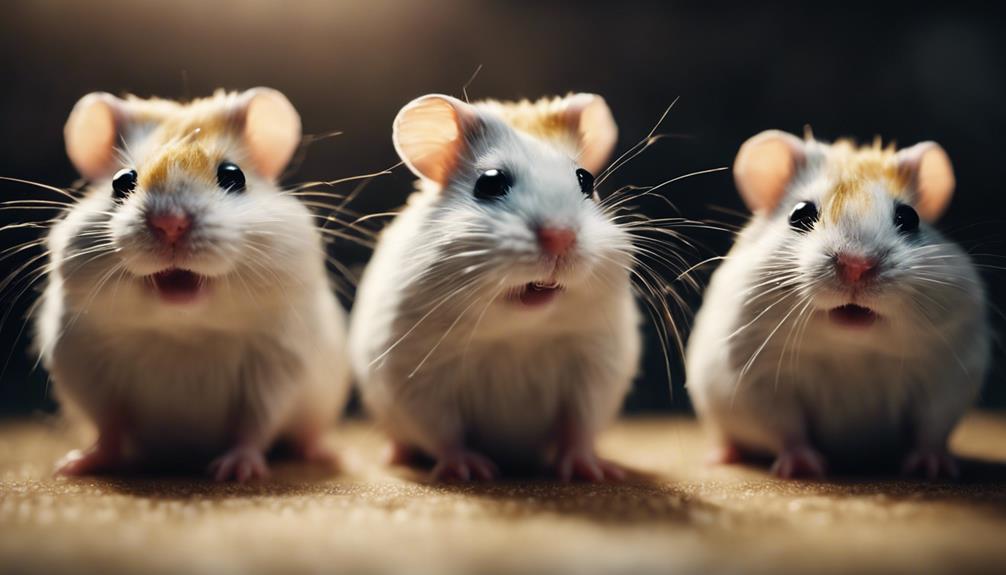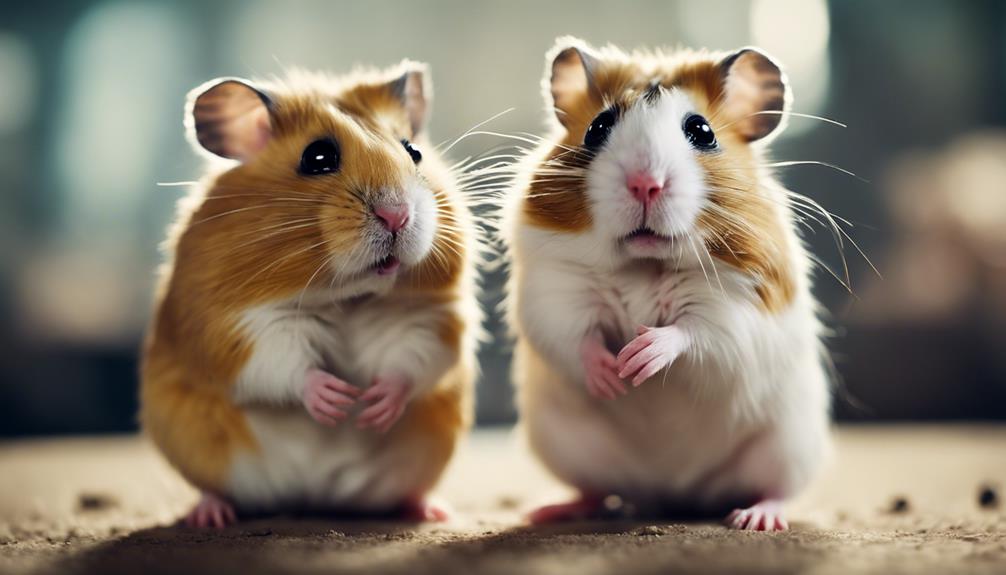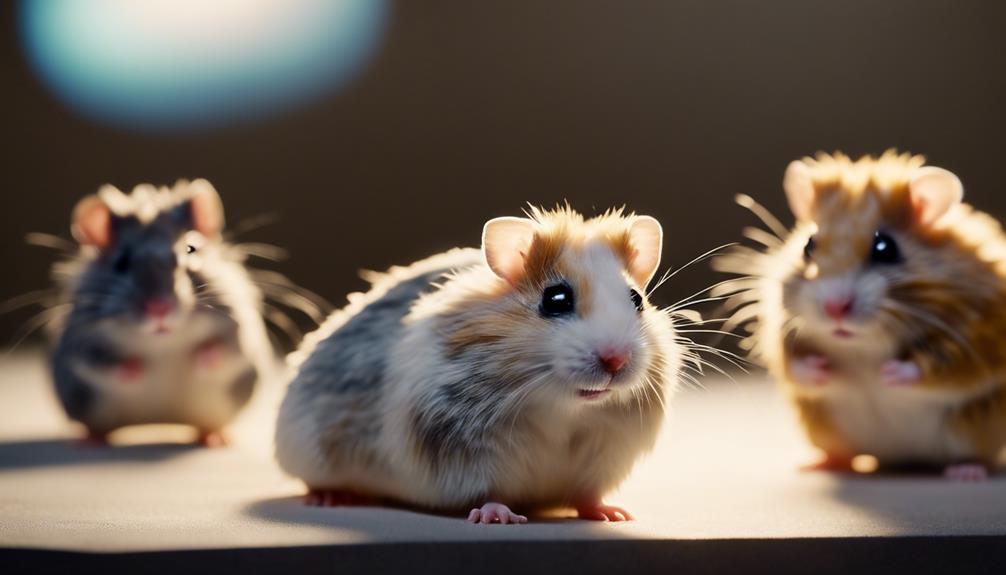Do Hamster Species Vary in Their Ability to Learn Tricks?

Yes, hamster species vary in their ability to learn tricks. Each species has its own unique cognitive capacities, with Syrian hamsters known for their sociable nature and dwarfs for their agility.
The differences in intelligence among hamster species make training an interesting and rewarding experience.
Understanding Hamster Intelligence Levels
In the realm of understanding hamster intelligence levels, one must delve beyond mere appearances to uncover the hidden depths of these curious creatures. Hamsters exhibit remarkable memory retention, which plays a vital role in their cognitive development. The ability to remember where they've hidden their food or how to navigate through their tunnels showcases their impressive cognitive capacities.
Moreover, hamsters possess noteworthy problem-solving skills. Whether it's figuring out how to access a treat hidden inside a puzzle toy or finding their way out of a maze, these small rodents display a surprising level of intelligence. Their problem-solving abilities not only serve as a form of mental stimulation but also highlight their adaptability to various situations.
Furthermore, social interactions play a significant role in understanding hamster intelligence levels. Observing how hamsters communicate, establish hierarchies, and engage with one another provides insights into their social intelligence. These interactions contribute to their overall cognitive development, shaping their behavior and responses to external stimuli.
Factors Influencing Learning Abilities
As researchers ponder the intricate workings of hamster minds, they're drawn to explore the factors that might influence their learning abilities. Genetic predispositions play a significant role in determining how easily hamsters grasp new tricks and tasks.
Additionally, the environment in which hamsters are raised, along with the level of mental stimulation and training they receive, can greatly impact their learning capabilities.
Genetic Influences on Learning
Genetic influences play a crucial role in shaping the learning abilities of different species, highlighting the intricate web of factors that contribute to cognitive development. Understanding genetic predispositions can offer insights into why some hamster species excel at learning tricks compared to others.
- Inherited Traits: Certain species may inherit genetic traits that predispose them to be more adept at learning complex tasks.
- Neurological Wiring: Genetic variations can influence the neurological wiring of hamsters, impacting their cognitive functions and learning capabilities.
- Behavioral Patterns: Genetic factors can shape the behavioral patterns of hamsters, influencing how they respond to training stimuli.
- Adaptation to Environment: Genetic predispositions may determine how quickly hamsters adapt to new environments and learning experiences.
Understanding these genetic influences is essential in unraveling the mysteries behind differences in learning abilities among hamster species.
Environmental Enrichment Effects
Amidst the vast array of factors influencing learning abilities, the impact of environmental enrichment stands out as a pivotal determinant in shaping the cognitive prowess of hamster species. Providing stimulating environments for these small creatures can lead to significant enrichment benefits, ultimately enhancing their cognitive performance and learning outcomes. When hamsters are exposed to a variety of toys, tunnels, and challenges in their environment, they are more likely to exhibit improved problem-solving skills, memory retention, and overall mental agility. This emphasis on creating dynamic surroundings for hamsters highlights the importance of considering the role of environmental enrichment in enhancing their learning capabilities.
| Environmental Enrichment Benefits | Cognitive Performance |
|---|---|
| Increased problem-solving skills | Enhanced memory retention |
| Mental agility improvement |
Behavioral Training Impact
In the realm of hamster learning abilities, the impact of behavioral training on cognitive development can't be overstated. When considering the behavioral training impact, several factors come into play:
- Training consistency: Regular and consistent training sessions help reinforce learning.
- Reinforcement methods: Positive reinforcement techniques like treats or praise can enhance the learning process.
- Individual hamster personalities: Each hamster has a unique personality that can influence their response to training.
- Motivation levels: Understanding what motivates a hamster can significantly impact their willingness to learn new tricks.
Syrian Hamsters: Natural Tricksters?
Syrian hamsters, known for their clever antics and quick wit, have long been considered natural tricksters in the world of small pets. These delightful creatures exhibit a wide range of behaviors that showcase their intelligence and adaptability. Syrian hamsters are curious by nature, often exploring their surroundings with great enthusiasm. This curiosity makes them excellent candidates for learning tricks, as they're eager to engage with their environment and interact with their owners.
In terms of learning preferences, Syrian hamsters tend to respond well to positive reinforcement techniques. Rewarding them with treats or praise when they perform a desired behavior can be highly effective in training them to do tricks. Additionally, these hamsters thrive on mental stimulation, so incorporating new challenges and activities into their routine can keep them motivated and engaged.
Dwarf Hamsters: Quick Learners or Not?

Known for their petite size and lively personalities, dwarf hamsters present a fascinating study in the realm of learning abilities among different hamster species. These tiny creatures often surprise their owners with their intelligence and agility. When it comes to training techniques for dwarf hamsters, patience and consistency are key. Motivation factors play a significant role in their learning process, with treats being a popular choice to encourage desired behaviors.
- Training Techniques: Gentle methods involving positive reinforcement work best with dwarf hamsters.
- Motivation Factors: Food rewards or praise can motivate dwarf hamsters to learn tricks effectively.
- Learning Speed: Dwarf hamsters are known for their quick learning abilities, picking up new tricks faster than some larger species.
- Reinforcement Methods: Regular reinforcement of learned behaviors is essential to ensure that dwarf hamsters retain their training and continue to perform tricks consistently.
Through a combination of appropriate training techniques, motivation factors, and consistent reinforcement methods, dwarf hamsters can indeed be quick learners when it comes to picking up new tricks and commands.
Comparing Roborovski Vs. Campbell Hamsters
Comparing the Roborovski and Campbell hamsters reveals distinctive traits that set these two species apart in terms of their learning abilities and behavior.
Roborovski hamsters, known for their energetic and curious nature, exhibit higher cognitive abilities compared to Campbell hamsters. Roborovskis are quick learners and tend to adapt well to new environments, making them more receptive to training methods. On the other hand, Campbell hamsters are more cautious and can be a bit shy, impacting their learning potential.
Behavior differences between these two species also play a significant role in their ability to learn tricks. Roborovski hamsters are typically more active and social, which can make them easier to train as they enjoy interaction with their owners. In contrast, Campbell hamsters may require more patience and gentle handling during training sessions due to their reserved demeanor.
Understanding these distinctions is crucial when considering which hamster species may be better suited for trick training. By recognizing the unique traits of Roborovski and Campbell hamsters, owners can tailor their training approaches to suit the individual needs of each species effectively.
Training Techniques for Hamster Tricks

To teach your hamster tricks effectively, start by establishing a positive and consistent training routine that incorporates rewards for desired behaviors. Positive reinforcement is key when training your furry friend, as it helps create a bond based on trust and mutual understanding. Incorporating clicker training can also be highly effective in marking the exact moment your hamster performs the desired behavior.
Here are some tips to make your training sessions successful:
- Use High-Value Treats: Offer treats that your hamster loves and finds irresistible to reinforce positive behaviors.
- Keep Sessions Short and Fun: Hamsters have short attention spans, so keep training sessions brief and engaging to maintain their interest.
- Be Patient and Consistent: Rome wasn't built in a day, and neither are trick-trained hamsters. Consistency is key to success.
- Celebrate Small Victories: Acknowledge and reward even the smallest progress your hamster makes towards learning a new trick.
Common Challenges in Teaching Tricks
When embarking on the journey of teaching tricks to your hamster, one common challenge that often arises is maintaining their focus throughout the training sessions. Hamsters are naturally curious and can easily get distracted, making it crucial to employ strategies that keep them engaged. Positive reinforcement and consistency are key tools in overcoming this challenge. By rewarding your hamster with treats or praise each time they exhibit the desired behavior, you reinforce their learning and encourage them to stay focused.
| Challenges | Solutions |
|---|---|
| Lack of focus | Use short, frequent sessions to prevent boredom. |
| Distractions | Choose a quiet, calm environment for training. |
| Limited attention span | Break down tricks into smaller steps for easier learning. |
Patience and creativity are also essential when facing challenges in teaching tricks to your hamster. Remember that each hamster is unique, and what works for one may not work for another. By approaching training with an open mind and adapting your methods as needed, you can overcome these obstacles and enjoy the process of bonding with your furry friend.
Tailoring Tricks to Different Hamster Species

How can hamster owners tailor tricks to suit the specific learning abilities of different hamster species? Each hamster species has unique characteristics that influence their learning capabilities and behavior. To effectively teach tricks to different hamster species, it's essential to consider these individual traits and adapt training methods accordingly.
- Trick customization: Modify tricks based on the natural tendencies and abilities of the specific hamster species. For example, Syrian hamsters may excel at tasks involving strength and agility, while Roborovski hamsters might be better suited for fast-paced tricks due to their energetic nature.
- Species characteristics: Understand the typical behaviors and preferences of each hamster species to tailor tricks that align with their natural instincts. For instance, Chinese hamsters are known for their climbing skills, so incorporating climbing elements into tricks can enhance their learning experience.
- Tailored training: Adjust the training pace and methods to cater to the learning speed and style of the particular hamster species. Some species may respond better to positive reinforcement, while others might require more patience and repetition.
- Hamster behavior differences: Recognize and accommodate the behavioral differences between hamster species when designing trick routines. Take into account factors such as sociability, energy levels, and attention spans to create engaging and effective training sessions for each species.
Frequently Asked Questions
Can Hamsters From Different Species Learn the Same Tricks, or Are There Limitations Based on Their Specific Species Traits?
When comparing cross-species abilities, hamsters may exhibit variations in learning tricks. Training techniques can influence behavior patterns and skill levels. Understanding individual species traits is crucial for successful training sessions and achieving desired results.
Are There Any Specific Tricks That Certain Hamster Species Excel at Compared to Others?
When it comes to training techniques for hamsters, species differences play a role in trick preferences and abilities. Some species might excel at certain tricks due to their inherent traits. Understanding these distinctions can aid in successful training sessions.
How Do Hamster Owners Determine the Best Training Approach for Their Individual Hamster's Learning Abilities?
When determining the best training approach for their hamster's learning abilities, owners should consider individual differences. By using various training techniques, implementing reward systems, and exercising patience, they can tailor a strategy suited to their furry friend's unique needs.
Do Factors Like Age or Gender Play a Role in a Hamster's Ability to Learn Tricks?
In the quest for the ultimate hamster trick mastery, age and gender stand as mere players in the grand stage of learning. The impact of environment, genetics, and consistent training techniques take center stage in unraveling the hamster's hidden potential.
Are There Any Tricks That Are Universally More Difficult for Hamsters to Learn, Regardless of Their Species?
When it comes to training hamsters, some tricks may pose universal challenges, regardless of species. Common challenges like teaching more complex behaviors or coordinating movements can be trickier, showcasing behavioral differences across various hamster species.









